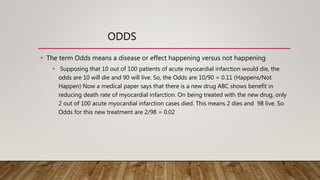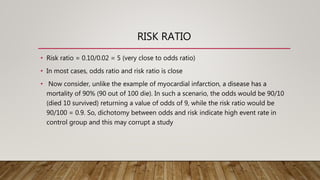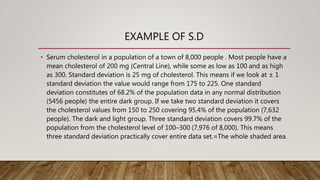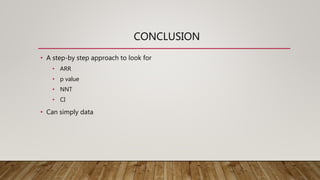Basics of medical statistics
- 1. BASICS OF MEDICAL STATISTICS SHARED FROM TINY NAIR (CSI UPDATE 2016)
- 2. KEYWORDS • PROBABILITY: (P) • SAMPLE SIZE • EFFECT SIZE • ODDS AND ODDS RATIO • RISK AND RISK RATIO • STANDARD DEVIATION • HOW TO USE SD INTELLIGENTLY • CONFIDENCE INTERVAL • HOW TO INTERPRET A CLINICAL TRIAL • CALCULATE NNT • TYPES OF TRIAL
- 3. PROBABILITY • Probability is an indicator of how much of the data can happen just by chance. p value of less than (<) 0.5 p <0.5 = 5/10 = ½ indicates that there is 50% chance that the result may be happening just because of a chance • p = 0.05 = 5/100 = 1/20 • To be statistically significant look for a p value of at least less than 0.05 • p <0.05 Statistically significant • p <0.01 Highly significant • p <0.001 Very highly significant • Always look at the sample size /confidence interval (CI) before giving a judgment on p value alone
- 4. SAMPLE & EFFECT SIZE • The value of p is inversely proportional to effect size and sample size • This means if we are testing the effects of a new blood pressure medicine is reducing blood pressure by 20 mm Hg, but was tested in only 100 patients, the p value may be significant but the sample size is too small to be significant. In similar lines, a drug reducing blood pressure by merely 1 mm Hg may return a significant p value, when tested in 1 million populations but the effect size is too small to be worthwhile statistically • To avoid statistical error, today the statistician calculates the minimum sample size that would be required to show a difference of results depending on the prevalence of the event rate in the natural course of the disease in the population being studied
- 5. ODDS • The term Odds means a disease or effect happening versus not happening • Supposing that 10 out of 100 patients of acute myocardial infarction would die, the odds are 10 will die and 90 will live. So, the Odds are 10/90 = 0.11 (Happens/Not Happen) Now a medical paper says that there is a new drug ABC shows benefit in reducing death rate of myocardial infarction. On being treated with the new drug, only 2 out of 100 acute myocardial infarction cases died. This means 2 dies and 98 live. So Odds for this new treatment are 2/98 = 0.02
- 6. ODD RATIO • Odds Ratio = control odds/Treatment Odds = 0.11/0.02 = 5.5 • This means treatment with this new drug reduces chance of death by 5.5 times
- 7. RISK AND RISK RATIO • Risk is a similar term that means disease or effect out of the entire population. In the same example of the heart attack above, the risk of death is 10 out of 100 (not 10/90 as in odds) Risk of death in MI 10/100 = 0.10 (Happens/Total) Similarly risk after being administered ABC has a risk of 2/100 = 0.02
- 8. RISK RATIO • Risk ratio = 0.10/0.02 = 5 (very close to odds ratio) • In most cases, odds ratio and risk ratio is close • Now consider, unlike the example of myocardial infarction, a disease has a mortality of 90% (90 out of 100 die). In such a scenario, the odds would be 90/10 (died 10 survived) returning a value of odds of 9, while the risk ratio would be 90/100 = 0.9. So, dichotomy between odds and risk indicate high event rate in control group and this may corrupt a study
- 9. STANDARD DEVIATION • Any physiological parameter will have variation from people to people • If we take sufficient number of people and plot their values, they tend to follow a normal or nominal distribution (a Bell-shaped curve) • The central line in the curve is the mean (akin to arithmetic average) • As we go farther away from the mean, the degree of deviation (from mean) increases • One standard deviation (1 SD) covers 68.2% of data spread from mean. 2SD covers more, up to 95.4% data and 3 SD covers almost a whooping 99.7% data
- 10. EXAMPLE OF S.D • Serum cholesterol in a population of a town of 8,000 people . Most people have a mean cholesterol of 200 mg (Central Line), while some as low as 100 and as high as 300. Standard deviation is 25 mg of cholesterol. This means if we look at ± 1 standard deviation the value would range from 175 to 225. One standard deviation constitutes of 68.2% of the population data in any normal distribution (5456 people) the entire dark group. If we take two standard deviation it covers the cholesterol values from 150 to 250 covering 95.4% of the population (7,632 people). The dark and light group. Three standard deviation covers 99.7% of the population from the cholesterol level of 100–300 (7,976 of 8,000). This means three standard deviation practically cover entire data set.=The whole shaded area.
- 12. CONFIDENCE INTERVAL • Confidence interval = 0.83 (CI 0.88–0.98) The upper value is below 1. So, it is statistically significant. However, clinical significance of a value is considered only when it is below 0.85. So, in this case, it is statistically significant, but clinically not significant • Confidence interval = 0.78 (CI 0.76–0.97) Here the upper value is below 1, while the lower one is below 0.85. Hence, it is statistically significant and may be clinically significant • Confidence interval = 0.78 (CI 0.57–1.12) Here the value wraps around 1, hence statistically not significant. However, since the lower value is below 0.85, it may still be clinically significant. In such cases, a repeat trial is indicated. • Confidence interval = 0.59 (CI 0.43 – 0.76) In this case, both the upper and lower values are below 0.85, so it is statistically as well as clinically significant
- 14. EXAMPLE • Journal Report New Drug XYZ Reduces Heart Failure Mortality by 20% • Study with a new drug XYZ’ for heart failure. • 5/1,000 patients died with standard care at end of 1 year=0.5% • 4/1,000 patients on XYZ died at end of 1 year=0.4% • Absolute risk reduction (ARR) – the real thing = 0.5 – 0.4 = 0.1% • Relative risk reduction (RRR) = 0.1/0.5 = 20% • The logical next step would be to check for p value, NNT and CI Look for p value •
- 15. CONTD……EXAMPLE • Accept if p < 0.05 • Many noninferiority trials try to show weather the drug or treatment is “not worse” compared to the present gold standard, but do not ask whether it is better or not. This means it is checking one end (single tail) of the standard bell curve and not both the ends (double tails). A single tailed trial needs a higher p value to be significant (at least p, 0.01) • Ask for confidence interval, if wraps around unity • Reject it (e.g. 0.56–1.23 goes to junk) • Enquire pre-specified endpoints.
- 16. NNT • Calculate NNT NNT is number needed to treat to prevent one event (let one Death) NNT is calculated by dividing 100/APR = 100/0.1 = 1000 So, you need to treat 1,000 patients to prevent one death • NNT is significant (acceptable) if more than 50 • Here ,it is 1,000, so not significant.
- 17. TYPES OF TRIAL • Observational studies: prevalence of a disease or its complications • Interventional studies: Randomized and placebo- controlled for guideline formation
- 18. TYPES OF TRIALS
- 19. CONCLUSION • A step-by step approach to look for • ARR • p value • NNT • CI • Can simply data
- 20. BIBLIOGRAPHY 1. Harris M, Taylor G, Dunitz M. Medical Statistics Made Easy. London and New York: Martin Dunitz; 2003. 2. Magnello E, Loon BV. Statistics, A graphic Guide. Icon Books, UK. 3. Mayer D. Essential Evidenced Based Medicine, Dan Mayer, Cambridge medicine, 2nd edn. US: Cambridge University Press; 2009. 4. Nair T. Medical Statistics and Clinical Trials, 1st edn. Wiley Blackwell. 5. Sanjay K, Diamond G. Trial and error: how to avoid commonly encountered limitations of published clinical trials, J Am Coll Cardiol. 2010;55:415-27.
- 21. DO YOU KNOW WHAT DOES CITY MEAN ? • C:Cutting • I:Innocent • T:Trees • Y:Yatra





















